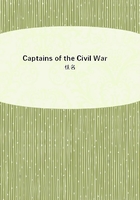
第67章 GETTYSBURG: 1863(3)
Lee, having invaded the North by marching northeast under cover of the mountains and wheeling southeast to concentrate at Gettysburg, found Buford's cavalry suddenly resisting him, as they formed the northwest outpost of Meade's army, which was itself concentrating round Pipe Creek, near Taneytown in Maryland, fifteen miles southeast. Gettysburg was a meeting place of many important roads. It stood at the western end of a branch line connecting with all the eastern rails. And it occupied a strong strategic point in the vitally important triangle formed by Pittsburgh, Philadelphia, and Washington. Thus, like a magnet, it drew the contending armies to what they knew would prove a field decisive of the whole campaign.
The Federal line, as finally held on the third of July, was nearly five miles long. The front faced west and was nearly three miles long. The flanks, thrown back at right angles, faced north and south. Near the north end of the front stood Cemetery Hill, near the south the Devil's Den, a maze of gigantic bowlders.
Along the front the ground was mostly ridged, and even the lower ground about the center was a rise from which a gradual slope went down to the valley that rose again to the opposite heights of Seminary Ridge, where Lee had his headquarters only a mile away. The so-called hills were no more than hillocks, the ridges were low, and most slopes were those of a rolling country. But the general contour of the ground, the swelling hillocks on the flanks (Culp's Hill on the right, the Round Tops on the left) and the broad glacis up which attackers must advance against the center, all combined to make the position very strong indeed when held by even or superior numbers.
The first day's fight began when A.P. Hill's Confederates, with Longstreet's following, closed in on Gettysburg from the west to meet Ewell's, who were coming down from the north. Buford's Federal cavalry resisted Hill's advanced brigades successfully till Reynolds had brought the First Corps forward in support and ordered the two other nearest corps to follow at the double quick. Reynolds was killed early in the day; but not before his well trained eye had taken in the situation at a glance and his sure judgment had half committed both armies to that famous field.
The full commitment came shortly after, when Meade sent Hancock forward to command the three corps and Buford's cavalry in their attempt to stem the Confederate advance. Howard was then the senior general on the field, having taken over from Doubleday, who had succeeded Reynolds. But he at once agreed that such a strong position should be held and that Hancock should proceed to rectify the lines. This was no easy task; for Ewell's Confederates had meanwhile come down from the north and driven in the Federal flank on the already hard-pressed front. The front thereupon gave way and fell back in confusion. But Hancock's masterly work was quickly done and the Federal line was reestablished so well that the Confederates paused in their attack and waited for the morrow.
The Confederates had got as good as they gave, much to their disgust. Archer, one of their best brigadiers, felt particularly sore when most of his men were rounded up by Meredith's "Iron Brigade." When Doubleday saw his old West Point friend a prisoner he shook hands cordially, saying, "Well, Archer, I AM glad to see you!" But Archer answered, "Well, I'm not so glad to see YOU--not by a damned sight!" The fact was that the excellent Federal defense had come as a very unpleasing surprise upon the rather too cocksure Confederates. Buford's cavalry and Reynolds's infantry had staunchly withstood superior numbers; while Lieutenant Bayard Wilkeson actually held back a Confederate division for some time with the guns of Battery G, Fourth U. S.
Artillery. This heroic youth, only nineteen years of age, kept his men in action, though they were suffering terrible losses, till two converging batteries brought him down.
He was well matched by a veteran of over seventy, John Burns, an old soldier, whom the sound of battle drew from his little home like the trumpet-call to arms. In his swallow-tailed, brass-buttoned, old-fashioned coatee, Burns seemed a very comic sight to the nearest boys in blue until they found he really meant to join them and that he knew a thing or two of war. "Which way are the rebels?" he asked, "and where are our troops? I know how to fight--I've fit before." So he did; and he fought to good purpose till wounded three times.
Late in the evening Meade arrived and inspected the lines by moonlight. Having ordered every remaining man to hasten forward he faced the second day with wellfounded anxiety lest Lee's full strength should break through before his own last men were up.
His right was not safe against surprise by the Confederates who slept at the foot of Culp's Hill, and his left was in imminent danger from Longstreet's corps. But on the second day Longstreet marked his disagreement with Lee's plans by delaying his attack till Warren, with admirable judgment, had ordered the Round Tops to be seized at the double quick and held to the last extremity.
Then, after wasting enough time for this to be done, Longstreet attacked and was repulsed; though his men fought very well.
Meanwhile Ewell, whose attack against the right was to synchronize with Longstreet's against the left, was delayed by Longstreet till the afternoon, when he carried Culp's Hill.
This was the only Confederate success; for Early failed to carry Cemetery Hill, the adjoining high ground, which formed the right center, and the rest of the Federal line remained intact; though not without desperate struggles.